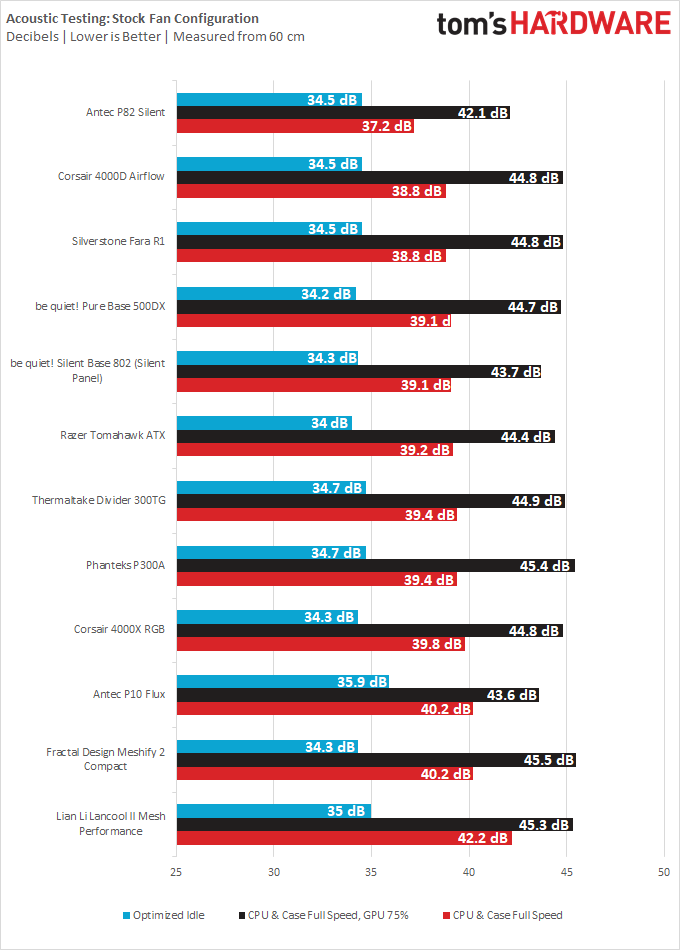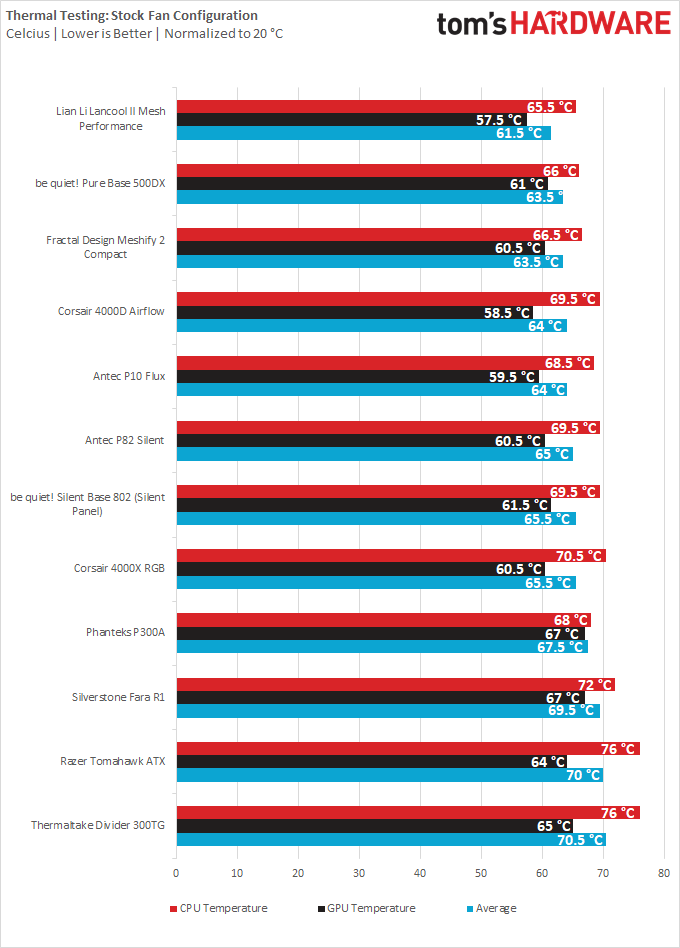Why you can trust Tom's Hardware
For thermal and acoustic testing, we are using the following software & settings:
| CPU Clock | i9 9900k: 4.6 GHz (46x 100MHz) @ 1.1v |
| GPU Clock | RTX 2070 Super: Stock |
| GPU Driver | Nvidia GeForce 445.87 |
| Case & CPU Fan Speeds | Stock Configuration 100%, Standardized CPU 100%, Case fans 50%. |
| GPU Fan Speeds | 75% |
Test Results
The three included fans might not be PWM models, but they offer an interesting RPM range: roughly 300 to 1000 RPM. That’s surprisingly low on the low-end for a DC fan, and 1000 RPM at the top end offers enough performance with pleasant acoustics.
Acoustic Results
For our acoustic tests, we run three scenarios: CPU full load, CPU and GPU full load, and an optimized idle. The CPU Full Load test runs the CPU and case fans at their maximum speed. For the CPU and GPU full load acoustic test we add the Nvidia RTX 2070 Super FE at 75% fan speed, because in practice it never runs at 100 percent and is far too loud when it does.
For the optimized idle, we run the GPU fan speed at 40 percent (the 2070 Super FE GPU does not have a Zero-RPM mode), and run the CPU and included case fans at the lowest speed they will spin at.

The acoustics of this case, which are surprising. Of course, this case does have ‘Silent’ slapped into its name, but I didn’t expect a chassis that offered performance that’s this much quieter than the competition. Of course, the majority of cases tested were mesh cases, so it’s not exactly a valid comparison, but even battling against be quiet!’s Silent Base 802 with its silent panel on, the Antec P82 Silent puts down a significantly better acoustic performance. The 1000 RPM fans help of course, but if you look at the damping qualities, Antec also gets something right with its foam as it’s able to keep the noise from the loud Founder’s Edition RTX 2070 at bay quite well. The foam is also in the P10 Flux, though that case came with much worse fans, placing it near the bottom of our chart, despite offering good damping qualities.
All that said, idle noise levels leave a bit to be desired. Even at 300 RPM, the fans do emit a bit of bearing noise, so for a silence-focused case, I was a little saddened not to be able to push it to inaudible levels under normal desktop use.
Thermal Results
For the thermal tests, all case and CPU fan speeds are set to 100 percent. The i9-9900K is pegged at a 4.6GHz clock at 1.1v on all cores to ensure consistent power consumption across test scenarios, and letting the GPU run at 75 percent fan speed enables it to maintain its power target while maintaining one set reasonable fan speed, so that the temperature is the only variable.
Get Tom's Hardware's best news and in-depth reviews, straight to your inbox.

Of course, with acoustics like these, we had expected thermals to suffer, but they didn’t. Results had the P82 Silent pegged right around the middle of our charts, not offering the best performance, but I’ve tested many cases that performed significantly worse.
Of course, normally with a case like this I’d say something like ‘most people don’t throw a 9900K and hot GPU at a case like this,’ in an effort to justify warmer thermals – but not this time – go ahead, throw that high-TDP GPU in here. It’ll be fine.
Conclusion
All things considered, I actually quite like the Antec P82 Silent. It’s a simple chassis, stepping back to the barebones necessities, and I appreciate that about it. It performs beyond expectations, is pleasant enough to build in, doesn’t cost much at about $60, and doesn’t draw unnecessary attention to itself.
I only have two real complaints: at idle, the fans still make a bit more bearing noise than I’d like, and there’s a bit of fiddling necessary with the fasteners – a third of the standoffs don’t come pre-installed, which would be fine if Antec provided the tool to do it properly, but alas it doesn’t. The side panel thumbscrews aren’t held in when undone. And the sliding expansion slot cover plate? Its thumbscrew gets in the way of a fastener required to fix the GPU in place. Of course, these are minor complaints in the grand scheme of things, but I have to complain about something, right? Besides, these things interrupt a build flow, which is a bummer when so many other case makers, including Antec itself, get these kinds of basics right, at least most of the time.
But don’t let that stop you from considering the P82 Silent. It’s a great simple chassis for understated systems, offering extremely good acoustics paired with surprisingly decent thermals. The P82 Silent is literally just a case, about as unexciting as they get, but sometimes that’s exactly what you’re after.
Niels Broekhuijsen is a Contributing Writer for Tom's Hardware US. He reviews cases, water cooling and pc builds.
-
JoBalz I used to use Antec cases exclusively back in the 1990s, but as case design improved in the 2000s, I haven't used one in about two decades. Now, this is the first one I've seen in all that time I like! Clean design, generally nice, open layout internally (prior cases have had many 3.5 and 5.25 inch drive bases, too many times immovable). Provisions for cable management, a PSU shroud, nice features. The one feature I've had a problems finding a case with is the side-mount power/reset buttons and USB ports. I set my mid-tower on my desk, not the floor, so side mounted buttons and ports are far more convenient than the top-mounted ones you find on a large percentage of cases (even front mounted ones are getting harder to find on tower cases).Reply
I did have to laugh at the amount of space this reviewer gave to the "issue" of a full complement of standoffs not being installed. Standoff tool? Back until the last decade, most cases did not install the standoffs at all, they were in a bag and you installed the ones required for your motherboard. Standoff tools? Those were called your fingers, or worst case, pliers. Just have to shake your head over what some people have issues with.
The case may not be perfect, but for my needs, this case would work perfectly and the price is practically a steal! I do keep hoping Antec will improve their case design team, they used to make great, well-designed cases at a good price point.
